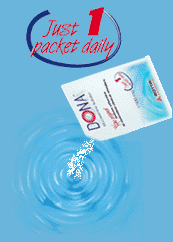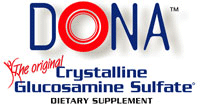 Loading... Please wait...
Loading... Please wait...
|

Order DONA™ through our new official corporate website: www.wynnpharm.com
|
||
|
DONA™ USA NEWS Efficacy of Glucosamine Sulfate in osteoarthritis of the lumbar spine: a placebo-controlled, randomized, double-blind study. Klaus K Foerster, Karl Schmid, and Lucio C Rovati Method: Prospective, placebo-controlled, double-blind and randomized clinical multicenter study in parallel-group design, and patients with cervical and/or lumbar spondylarthrosis, demonstrated by pain and movement limitation for at least six months, and positive radiology. Clinic visits were performed at enrolment, after three weeks, at the end of the six weeks treatment (1.500 mg GS or placebo, once daily) as well as four weeks after drug discontinuation. Main parameter of evaluation was the clinical investigator´s overall judgement after six weeks of treatment, secondary parameters were patient´s global assessment, pain severity measured by a visual analogue scale (VAS), limitation of function measured by several functionional tests, morning stiffness, interference with daily activities and, concerning safety, adverse events (AEs), and laboratory parameters. Results: Of 160 enrolled out-patients with cervical and/or lumbar spondylarthrosis, 92 patients (76 women, 16 men; mean age of 64.2 years) were randomly assigned to either the verum group (43 patients) or to the placebo group (49 patients). All patients completed the study. Concerning the investigator’s global judgement at the end of treatment, 51.2 %GS patients showed either definetely improved ”or” improved symptoms, versus 28.6% placebo group patients (p=0.034). Concerning the patient’s global assessment, figures were higher: 67.5 versus 58.8% (not significant, n.s.). GS induced a more pronounced, in part statistically significant, decrease in severity of all pain parameters, and this effect was maintained after drug discontinuation at the end of six weeks. A similar pattern was found concerning movement limitation. Morning stiffness and interference with daily activities was positively and in a greater extent influenced by GS. Tolerability was comparably good (16% versus 10% AEs;n.s.). Conclusions: As already well established in osteoarthritis of the knee [Muller-Fassbender and Bach 1990;Noack et al.1994 ], GS has a significantly better symptomatic efficacy than placebo in controlling pain and movement limitation in lumbar spondylarthrosis. This effect lasts on after the end of treatment,whereby safety of GS is very good and comparable to that of placebo.
|
||




